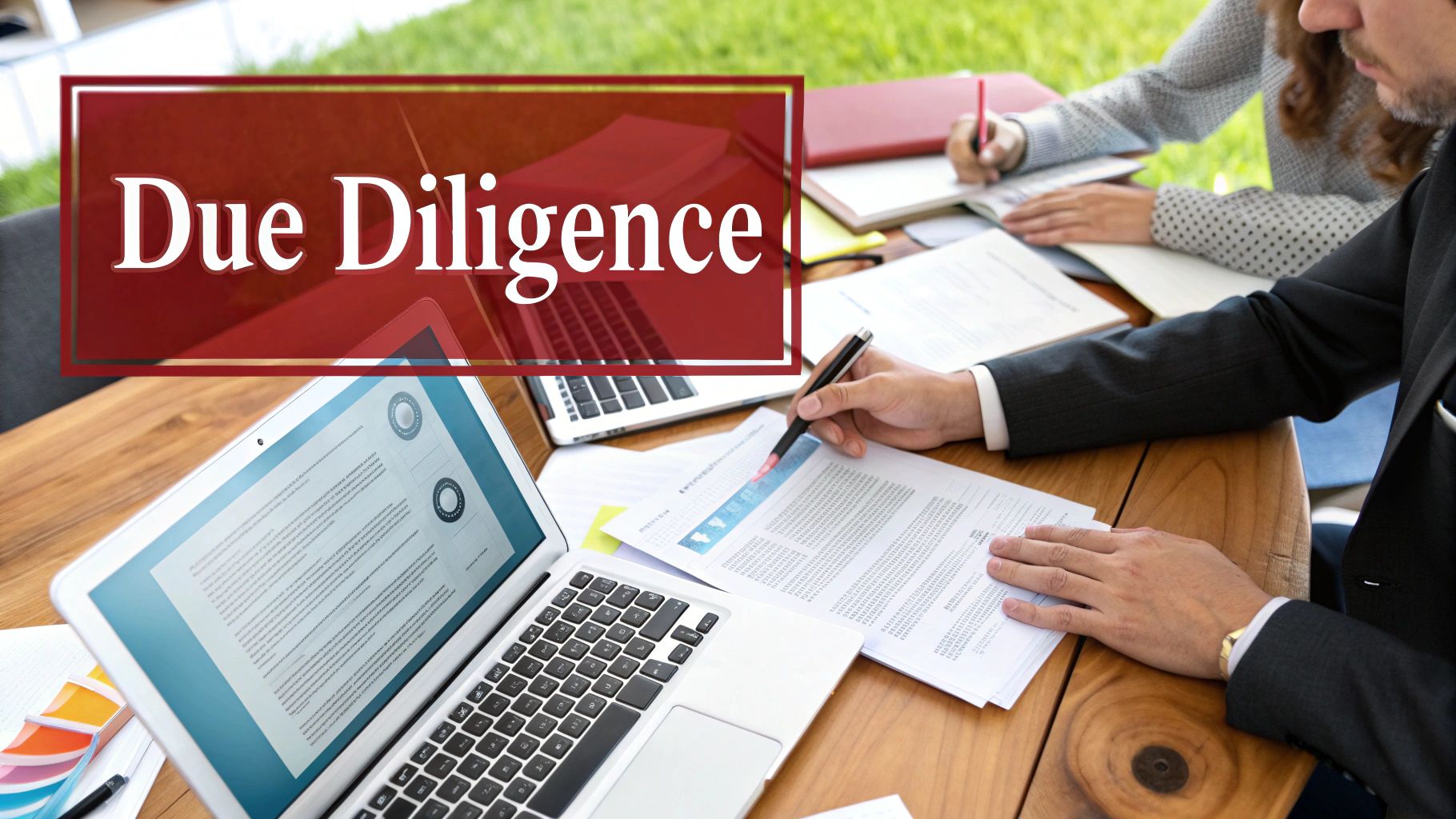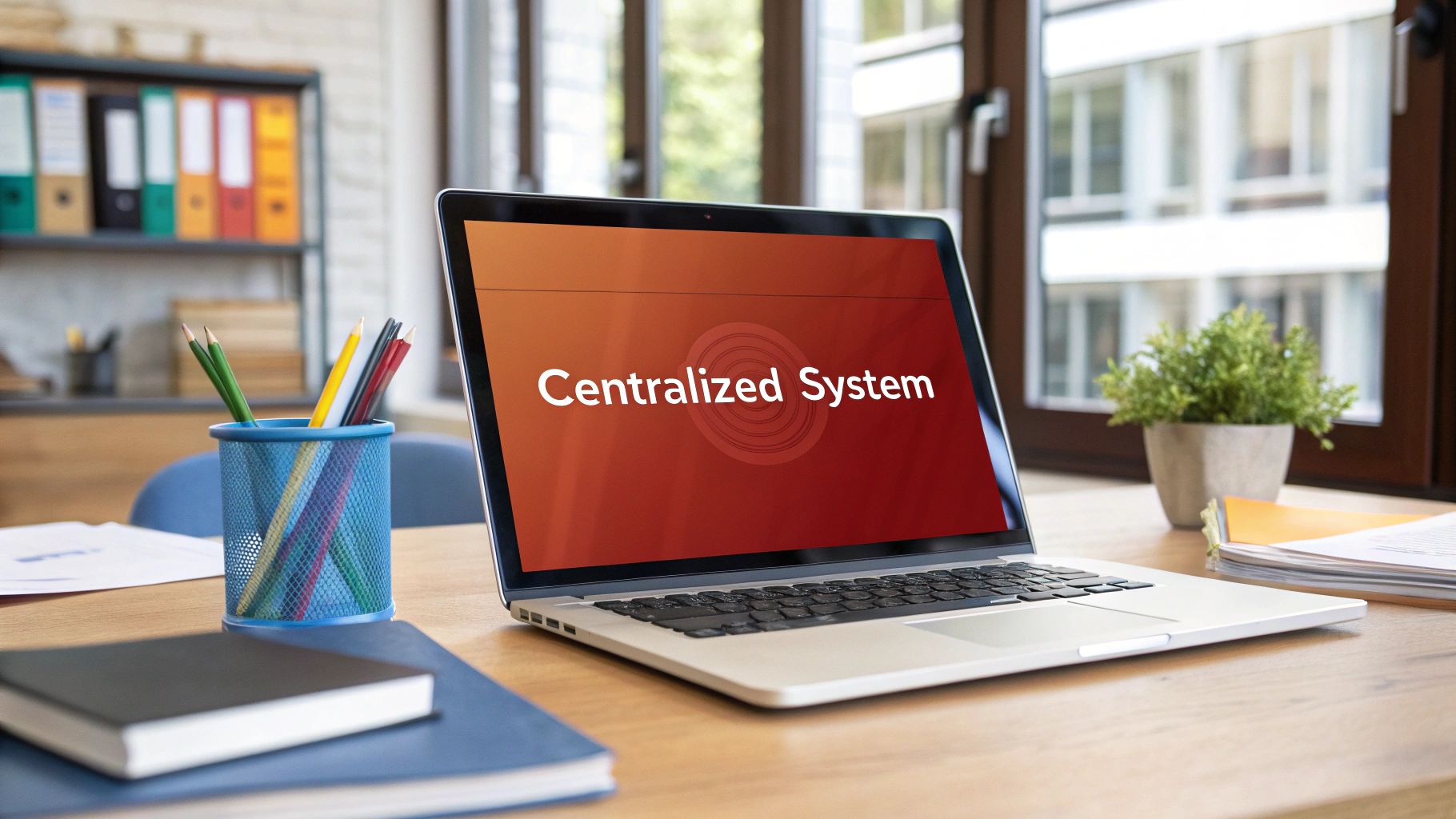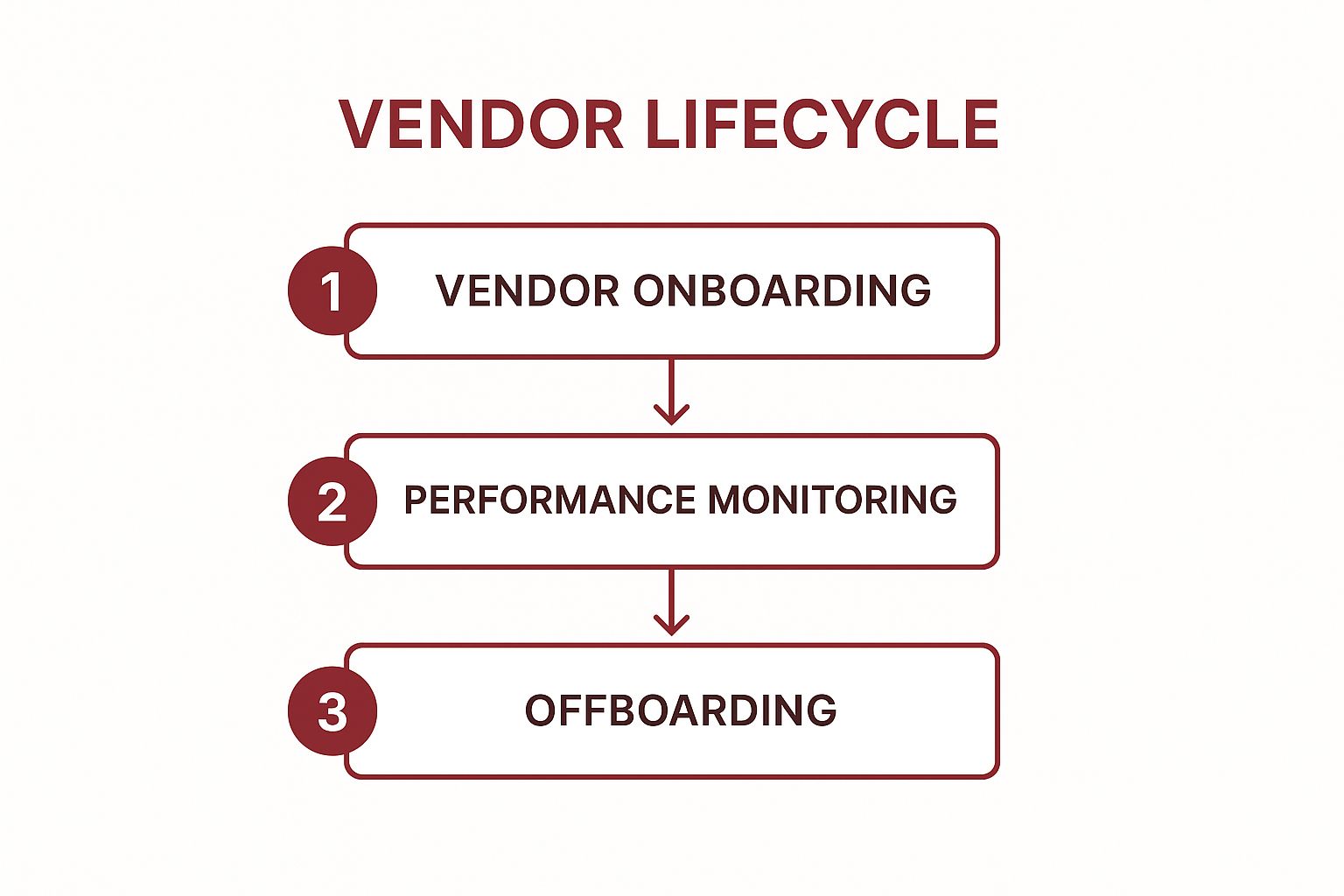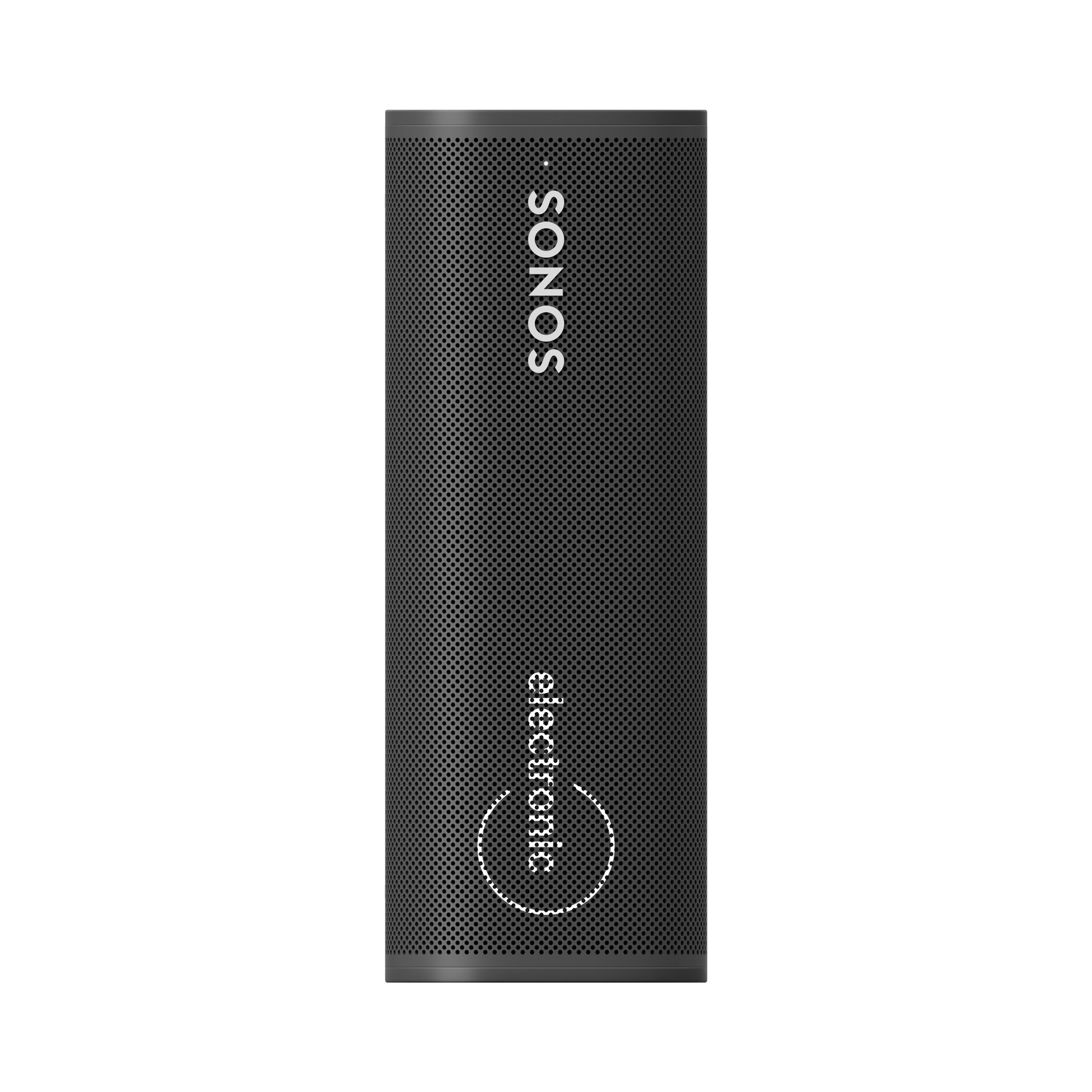In today's interconnected business ecosystem, vendors are far more than just suppliers; they are integral partners driving innovation, growth, and operational resilience. For corporate marketing and procurement teams, managing these relationships effectively has moved from a simple administrative task to a core strategic function. Moving beyond transactional exchanges to build robust, value-driven partnerships requires a structured and deliberate approach. This is where mastering the best practices for vendor management becomes essential.
This guide cuts directly to the actionable strategies you need. We will outline a comprehensive framework that transforms your vendor processes, mitigates critical risks, and unlocks the maximum potential from every partnership. From initial due diligence and rigorous contract negotiation to proactive performance monitoring and strategic relationship building, these principles provide a clear roadmap.
By implementing these proven methods, you can construct a world-class vendor management program. The goal is to build a resilient, high-performing, and collaborative network of external partners that functions as a true extension of your own team. Whether you are a tech startup scaling rapidly or a Fortune 100 company refining its supply chain, these insights will help you establish a powerful competitive advantage through superior vendor collaboration.
1. Due Diligence and Vendor Evaluation
Effective vendor management begins long before you sign a contract. It starts with a rigorous and systematic evaluation process to ensure potential partners are not just capable, but also reliable, secure, and aligned with your company’s values. This proactive approach minimizes future risks and sets the stage for a successful, long-term relationship.

The cornerstone of successful vendor evaluation is conducting thorough due diligence to assess potential partners comprehensively. This goes beyond a simple price comparison to include a deep dive into financial stability, operational capacity, security protocols, and regulatory compliance. For instance, Microsoft’s vendor program reportedly assesses suppliers against over 200 criteria, ensuring alignment across all business facets.
How to Implement a Robust Evaluation Process
A structured approach is key to consistently selecting high-quality vendors. This is one of the most critical best practices for vendor management as it prevents costly mistakes down the line.
- Develop Standardized Scorecards: Create a consistent evaluation template with weighted criteria for aspects like cost, quality, security, and cultural fit. This ensures objectivity when comparing multiple vendors.
- Involve Cross-Functional Teams: Include stakeholders from IT, finance, legal, and the department that will use the vendor’s services. Their diverse perspectives help identify potential issues that a single team might miss.
- Validate Credentials and Capabilities: Don't just take their word for it. Request proof of certifications (like ISO 27001 for security) and consider running a small-scale pilot project or proof-of-concept to test their capabilities in a real-world scenario before full commitment.
By establishing a detailed and non-negotiable evaluation framework, you create a strong foundation for your entire supply chain. You can explore these concepts further by reading about supply chain best practices in more detail.
2. Clear Contract Terms and Service Level Agreements (SLAs)
A handshake and a verbal agreement are insufficient in modern business. The foundation of a strong vendor partnership is a comprehensive, legally-sound contract that leaves no room for ambiguity. This document formally outlines all expectations, deliverables, timelines, responsibilities, and consequences, creating a single source of truth that protects both parties and ensures alignment from day one.

Central to this is the Service Level Agreement (SLA), which translates broad goals into measurable performance metrics. For example, Amazon Web Services (AWS) famously provides detailed SLAs with specific uptime guarantees like 99.99% and offers service credits for any deviation. Similarly, Accenture often structures outcome-based contracts where payments are directly linked to achieving predefined performance targets. This approach transforms the contract from a static document into a dynamic performance management tool.
How to Implement Watertight Contracts and SLAs
Crafting a precise contract is one of the most crucial best practices for vendor management, as it prevents disputes and sets clear performance benchmarks. A well-defined agreement is your primary tool for accountability.
- Specify Measurable Metrics: Define performance criteria that are specific, measurable, achievable, relevant, and time-bound (SMART). Instead of "good uptime," specify "99.9% server uptime measured monthly."
- Define Escalation and Resolution Procedures: Clearly outline the step-by-step process for reporting issues, the required response times, and the chain of command for escalating unresolved problems.
- Incorporate Flexibility and Review Clauses: Business needs change. Include clauses that allow for periodic reviews and adjustments to the contract and SLAs, ensuring the agreement remains relevant and effective over time. This also presents an opportunity to explore procurement cost savings strategies during renegotiations.
By meticulously defining the terms of engagement, you establish a transparent and enforceable framework that minimizes risk and drives vendor performance.
3. Regular Performance Monitoring and Review
A signed contract is not the end of the vendor management process; it's the beginning of an ongoing relationship that requires continuous oversight. Systematic performance monitoring ensures that vendors consistently deliver on their promises, meet quality standards, and adhere to contractual obligations. This proactive tracking allows you to identify and address issues before they escalate into major business disruptions.

The foundation of effective monitoring is measuring performance against predefined Key Performance Indicators (KPIs) and Service Level Agreements (SLAs). Beyond just setting clear terms, continuous Service Level Agreement (SLA) monitoring is essential to ensure vendors meet agreed-upon performance standards. For example, Walmart utilizes a detailed supplier scorecard system that evaluates vendors across critical metrics like on-time delivery, product quality, and cost-effectiveness, driving accountability and continuous improvement throughout its supply chain.
How to Implement Continuous Performance Reviews
A structured review cadence transforms vendor management from a reactive, problem-solving function into a strategic, value-adding one. This is one of the most vital best practices for vendor management as it protects your investment and ensures ongoing alignment.
- Focus on Impactful Metrics: Track KPIs that directly influence business outcomes, such as uptime for a software vendor or lead quality for a marketing agency, rather than getting lost in vanity metrics.
- Conduct Regular Business Reviews (QBRs): Schedule monthly or quarterly meetings with key vendors to discuss performance data, review successes, address challenges, and plan for the upcoming period.
- Develop Performance Improvement Plans (PIPs): When a vendor is underperforming, collaborate on a formal PIP with clear, time-bound objectives and specific actions required to get back on track.
- Recognize and Reward Excellence: Acknowledge and reward vendors who consistently exceed expectations. This can strengthen the partnership and motivate them to maintain high standards of service.
4. Risk Assessment and Mitigation Strategies
Proactive risk management is a non-negotiable component of modern vendor relationships. It involves a systematic process of identifying, analyzing, and neutralizing potential threats before they can disrupt your operations. A comprehensive framework protects your business from financial, operational, compliance, and reputational damage stemming from third-party actions.
This practice moves beyond simple oversight to active threat management. For instance, following its 2013 data breach, Target implemented drastically enhanced vendor security requirements, demonstrating how a reactive measure can become a proactive industry standard. Similarly, JPMorgan Chase’s robust third-party risk management program oversees tens of thousands of vendors, applying rigorous controls based on the level of risk each one presents.
How to Implement a Proactive Risk Framework
Implementing a structured risk framework is one of the most crucial best practices for vendor management, as it builds resilience into your supply chain.
- Conduct Regular Risk Assessments: Don't treat risk assessment as a one-time event. Schedule periodic reviews (at least annually or when a major change occurs) to re-evaluate vendor risks, including operational, financial, and cybersecurity postures.
- Develop Contingency and Response Plans: For every critical vendor, create a clear incident response plan. What happens if they have a service outage, a data breach, or go out of business? Having an alternative vendor on standby or a clear action plan is essential.
- Establish Clear Risk-Based Controls: Implement controls tailored to the risk level. This could include requiring specific cybersecurity insurance, demanding security certifications like ISO 27001, or mandating regular performance audits.
Beyond traditional risks, assessing environmental impact and implementing strategies to reduce supply chain carbon emissions is becoming a vital part of comprehensive vendor risk management. You can learn more about these Risk Assessment and Mitigation Strategies on electronicfinishing.solutions.
5. Centralized Vendor Management System
As your organization grows, managing vendor relationships through spreadsheets and scattered email threads becomes unsustainable and risky. Implementing a unified platform that consolidates all vendor-related information, processes, and interactions is a critical step toward strategic control. A centralized system provides a single source of truth for contracts, performance data, and communications, enabling greater visibility and efficiency across the board.
The core benefit of this approach is streamlined coordination and data integrity. By centralizing information, you eliminate silos and empower teams with real-time access to the data they need to make informed decisions. For example, procurement giants like SAP Ariba and Coupa offer platforms that companies like Coca-Cola and Salesforce use to manage everything from sourcing and contracts to payments and risk assessment in one integrated environment.
How to Implement a Centralized System
Choosing and implementing a vendor management system (VMS) requires a strategic approach to ensure it meets your specific business needs and drives user adoption.
- Prioritize Integration Capabilities: Select a system that integrates smoothly with your existing enterprise software, such as your ERP or accounting platforms. This prevents data fragmentation and manual data entry errors.
- Focus on Change Management: A new system is only as good as its users. Provide comprehensive user training and ongoing support to ensure teams are comfortable and proficient with the platform, maximizing your ROI.
- Establish Clear Data Governance: Create and enforce strict policies for how vendor information is entered, updated, and managed. This ensures the data within your system remains accurate, secure, and reliable for decision-making and compliance.
By adopting a centralized system, you transform vendor management from a reactive, administrative task into a proactive, strategic function. This is especially crucial when managing complex logistics, such as understanding the nuances of direct-to-consumer fulfillment, where vendor coordination is key.
6. Strong Communication and Relationship Building
Beyond contracts and performance metrics lies the human element of vendor management. Treating vendors as transactional entities rather than strategic partners is a missed opportunity. Building strong, communicative relationships transforms the dynamic from a simple service exchange into a collaborative partnership, fostering innovation, loyalty, and mutual growth. This is a core tenet of modern, effective vendor management.
The goal is to move beyond purely transactional interactions to build trust and alignment. A powerful example is Toyota’s long-standing approach with its suppliers, where it invests in their development and engages in deep, collaborative planning. This fosters a resilient and innovative supply chain that benefits all parties, demonstrating how relationship-building is one of the most impactful best practices for vendor management.
How to Foster Strong Vendor Relationships
A structured communication plan ensures that both parties remain aligned on goals, challenges, and opportunities. This proactive approach prevents misunderstandings and turns potential issues into collaborative problems to solve together.
- Assign Dedicated Relationship Managers: For high-value, strategic vendors, assign a specific point of contact or relationship manager. This individual is responsible for nurturing the partnership and acts as the central hub for all communication.
- Establish a Regular Communication Cadence: Don’t wait for problems to arise. Schedule regular meetings, such as quarterly business reviews (QBRs) and weekly operational check-ins, to discuss performance, upcoming projects, and feedback.
- Create Shared Goals and Celebrate Wins: Work with key vendors to establish shared success metrics that align with your business objectives. When you achieve these goals together, make it a point to celebrate the joint success and publicly recognize the vendor's contribution.
7. Compliance and Security Management
Beyond performance and cost, vendor relationships must be built on a foundation of trust and regulatory adherence. This involves a comprehensive approach to ensuring vendors meet all required legal, security, and industry-specific standards. Managing compliance isn't a one-time check during onboarding; it's a continuous process of verification, monitoring, and risk mitigation throughout the entire relationship lifecycle.
The core of this practice is integrating compliance management directly into your vendor management framework to protect your organization from legal penalties, data breaches, and reputational damage. For instance, healthcare organizations must ensure every vendor handling patient data is rigorously HIPAA compliant, while financial services firms enforce strict controls to meet SOX and other regulatory mandates. These non-negotiable standards are critical best practices for vendor management.
How to Implement Ongoing Compliance and Security
A proactive and structured compliance program is essential for protecting sensitive information and maintaining regulatory good standing. This systemizes how you track and enforce crucial security protocols.
- Maintain a Compliance Inventory: Create and regularly update a detailed inventory of all regulatory and security requirements applicable to each vendor. This includes industry standards like PCI DSS for payment processors or ISO 27001 for data security.
- Automate Monitoring and Alerts: Implement automated systems to monitor for changes in regulations and track vendor compliance status. These tools can send alerts when a vendor’s certification is about to expire or if a new risk is identified.
- Conduct Regular Security Audits: Don't rely solely on vendor attestations. Schedule regular security assessments, vulnerability scans, and penetration tests for high-risk vendors to independently verify their security posture and data protection measures.
By embedding robust compliance and security management into your processes, you build a resilient supply chain capable of navigating a complex and ever-changing regulatory landscape.
8. Vendor Lifecycle Management
Adopting a vendor lifecycle management approach means treating your partnerships as a complete journey with distinct phases. This structured process guides a vendor relationship from initial identification and onboarding, through performance management and optimization, to eventual offboarding or renewal. This comprehensive view ensures consistent handling and maximizes value at every stage.
Managing the entire lifecycle is one of the most crucial best practices for vendor management because it prevents value leakage and ensures strategic alignment over the long term. For instance, General Electric's supplier development and lifecycle initiatives focus on continuous improvement throughout the partnership, not just during initial sourcing. This holistic strategy ensures that vendors evolve alongside business needs.
How to Implement Vendor Lifecycle Management
A structured, phase-based approach prevents oversights and helps you proactively manage each relationship from start to finish. This ensures smooth transitions and sustained performance.
- Standardize Processes for Each Phase: Develop and document clear, repeatable processes for each stage: sourcing, due diligence, onboarding, performance monitoring, and offboarding. This creates consistency and efficiency across your entire vendor portfolio.
- Create Clear Transition and Offboarding Plans: Don't wait until a contract ends to plan for the future. Develop detailed transition plans for vendor changes or terminations to ensure business continuity, data security, and a smooth handover of responsibilities.
- Maintain Comprehensive Documentation: Keep a centralized, accessible record of all vendor interactions, contracts, performance reviews, and communications throughout their lifecycle. This history is invaluable for audits, performance analysis, and future decision-making.
By strategically managing the entire vendor journey, you transform a series of transactional interactions into a cohesive, value-driven partnership that supports your long-term business objectives.
10. Implement a Structured Vendor Lifecycle Management Process
Vendor relationships are not static; they evolve from onboarding to offboarding. Implementing a structured vendor lifecycle management (VLM) process ensures that every stage of the relationship is managed consistently and effectively. This holistic approach standardizes interactions, mitigates risks, and maximizes value across the entire partnership, from initial setup to eventual termination.

The infographic above illustrates the core stages of a typical vendor lifecycle, which are essential for comprehensive oversight. Treating these stages as a connected flow rather than isolated events is a key component of the best practices for vendor management. A formal VLM framework, like the one used by procurement leaders at companies such as Cisco, ensures that nothing falls through the cracks, particularly during transitions.
How to Manage the Vendor Lifecycle
A well-defined process for each phase is critical for consistency and control. This ensures smooth operations and clear expectations for both parties throughout the engagement.
- Standardize Onboarding: Develop a repeatable onboarding checklist. This should include collecting necessary documentation (tax forms, insurance certificates), integrating the vendor into your payment systems, and clearly communicating points of contact and performance expectations.
- Continuous Performance Monitoring: As covered in other best practices, this middle stage is where the relationship lives. Regularly track performance against KPIs and conduct periodic business reviews.
- Establish a Formal Offboarding Protocol: Create a clear offboarding process for when a contract ends. This must include steps for data return or destruction, revoking system access, finalizing payments, and conducting an exit review to capture lessons learned.
Top 10 Vendor Management Best Practices Comparison
| Item | Implementation Complexity 🔄 | Resource Requirements ⚡ | Expected Outcomes 📊 | Ideal Use Cases 💡 | Key Advantages ⭐ |
|---|---|---|---|---|---|
| Due Diligence and Vendor Evaluation | High – involves detailed assessments | High – requires expertise & time | Risk reduction, strategic alignment | Vendor selection, risk avoidance | Identifies red flags early, ensures fit |
| Clear Contract Terms and SLAs | Medium to High – complex negotiation | Medium – legal and managerial | Clear expectations, measurable performance | Contract setup, legal protection | Legal recourse, accountability, clarity |
| Regular Performance Monitoring and Review | Medium – ongoing tracking and reviews | Medium to High – monitoring tools | Continuous improvement, proactive issue detection | Performance management, vendor accountability | Data-driven insights, strengthens relationships |
| Risk Assessment and Mitigation Strategies | High – detailed risk framework | High – analysis and planning | Risk minimization, compliance | Risk management, regulatory adherence | Crisis preparedness, informed decisions |
| Centralized Vendor Management System | High – system implementation & training | High – technology & change mgmt | Enhanced visibility & control | Large-scale vendor coordination | Efficiency, compliance, data-driven decisions |
| Strong Communication and Relationship Building | Medium – ongoing engagement | Medium – dedicated personnel | Trust building, collaboration | Partnership development, conflict reduction | Better innovation, issue resolution |
| Compliance and Security Management | High – regulatory and audit activities | High – expert monitoring | Reduced legal risk, data protection | Regulated industries, security-sensitive vendors | Maintains certifications, stakeholder trust |
| Vendor Lifecycle Management | Medium to High – end-to-end process | Medium to High – structured management | Consistency, maximum vendor value | Long-term vendor programs, comprehensive control | Consistency, risk reduction, optimization |
From Checklist to Competitive Edge: Implementing Your Vendor Management Strategy
Navigating the complexities of modern business requires more than just high-quality products or services; it demands a robust, resilient, and strategically aligned network of external partners. The journey from a reactive, ad-hoc approach to a proactive, strategic vendor management program is transformative. It's the difference between treating vendors as mere line items on a budget and cultivating them as essential extensions of your team, dedicated to mutual success.
We have explored the foundational pillars of effective vendor management, from conducting meticulous due diligence and crafting ironclad contracts to fostering strong relationships and implementing centralized systems. These aren't just isolated tasks on a checklist. They are interconnected components of a comprehensive strategy that protects your organization, enhances efficiency, and unlocks new avenues for innovation. Mastering these best practices for vendor management is not simply about mitigating risk; it’s about building a powerful competitive advantage.
Key Takeaways for Immediate Action
To translate this knowledge into tangible results, focus on these critical takeaways:
- Strategy Over Administration: Shift your perspective. Vendor management is not just an administrative function for procurement or marketing teams; it is a strategic discipline that directly impacts your bottom line, brand reputation, and operational agility.
- Data-Driven Decisions: Replace assumptions with analytics. Use performance metrics, regular reviews, and centralized data to objectively assess vendor value, identify potential issues before they escalate, and make informed decisions about your vendor portfolio.
- Relationships are Your Asset: Technology and contracts are crucial, but the human element is what truly separates successful partnerships from transactional ones. Invest time in building trust, establishing open communication channels, and aligning on shared goals.
Your Path to Vendor Management Excellence
Embarking on this path doesn't require a complete organizational overhaul overnight. The most effective approach is incremental and targeted. Start by assessing your current vendor management maturity. Identify the one or two areas from this guide, perhaps risk assessment or performance monitoring, that present the most significant gaps or opportunities for your business.
Create a small, cross-functional team to pilot a new process for a single, high-impact vendor category. Document your wins, learn from the challenges, and then methodically scale the successful practices across the organization. This continuous cycle of implementation, assessment, and refinement is the hallmark of a world-class vendor management program. By adopting this mindset, you ensure that every vendor relationship, from your largest global supplier to a niche service provider, actively contributes to your strategic objectives, delivering sustained value year after year.
Looking for a partner that exemplifies these best practices? When it comes to high-touch services like custom-branded electronics and direct-to-customer fulfillment, you need a vendor you can trust implicitly. Electronic Finishing Solutions builds partnerships grounded in transparency, performance, and impeccable execution, ensuring your brand is represented flawlessly. Discover the difference a strategic finishing partner can make at Electronic Finishing Solutions.



